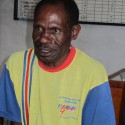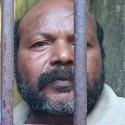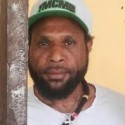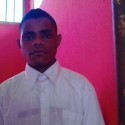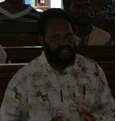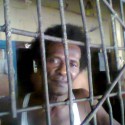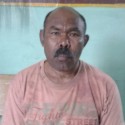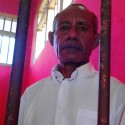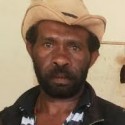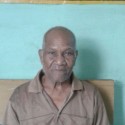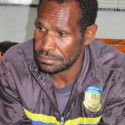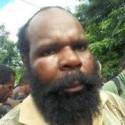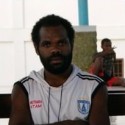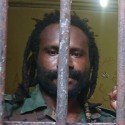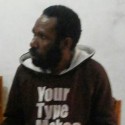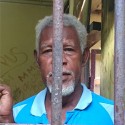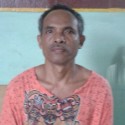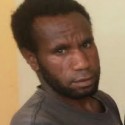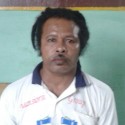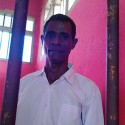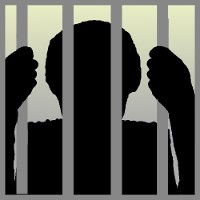
Nelson Rumbiak was a student before he was arrested and sentenced to six years imprisonment as a consequence of the violence surrounding the 16th of March 2006. A picket had started the day before, demanding the closure of the Freeport mine in Tembagapura and the withdrawal of the police and military from the area. The Justice and Peace Secretariat (Sekretariat Keadilan dan Perdamaian or SKP) have published a detailed daily chronology of the events as they unfolded in 2006 later compiled into a book “Memoria Passionis di Papua”. They record that clashes began at 12.15 on the 16th as some demonstrators threw stones and bottles at the police, and then the confrontation intensified as police tried to storm the blockade. Three policemen and one Air Force Intelligence officer died in the fighting, and another policeman was to die from his injuries on March 22nd.
Mr Rumbiak was arrested at 2am on March 4th in Abepura. He was charged with Section 365 of the Indonesian Penal Code, which refers to theft with violence. We have found no record of what he was supposed to have stolen, and he was the only one of the 23 Abepura prisoners to be charged with this offence.
All 23 men who were indicted in the aftermath of the Abepura clashes were subjected to various degrees of torture, which were later investigated by the Indonesian Working Group on the Advocacy Against Torture. Mr Rumbiak complained that he had been beaten with an iron bar, punched and kicked. The torture, which took place at the Mobile Brigade Papuan Headquarters and the Papuan Police headquarters, resulted in swelling around his eyes and temporary loss of vision. He also was bleeding from his mouth and nose and had swellings around his face, back and other parts of his body.
Sixteen of the twenty-three indictees were tried together, and usually appeared in court on the same day. Several groups have highlighted the trial process as particularly unfair, and characterised by intimidation. For example, the ‘Advocacy team for the Abepura Clash of 16 March 2006’ published a report into the trial proceedings. Their report claimed that the prosecutor and judges were focussed on reaching an outcome that was already decided. They based their arguments on the initial interrogation reports (BAP) which most of the defendants refuted as they contained statements made under torture.
The atmosphere in the trial was said to be intimidating with several uniformed and plain-clothes police and intelligence agents present at each session. At two sessions, on the 17th and 24th May, defendants were injured or received death threats from police Mobile Brigade Brimob) members after they rejected the indictments. Meanwhile Amnesty International has reported that police beat the men with rifle butts and rubber batons two hours before they were due to appear in court, to try to force them to confess.
Nelson Rumbiak was sentenced to six years in prison on the 24th July 2006. This sentence was two years more than the four years that the prosecutors had asked for, in line a pattern which emerged for all the prisoners in this case.
After being convicted, Mr Rumbiak was called upon to testify for the prosecution in the trials of seven other men accused for the same incident. In court, he rejected the testimony that policemen had given. In response, when he left the court, several policemen were waiting and beat him with rattan rods until he fell to the ground, whereupon they kicked him with their boots. Mr Rumbiak was taken to hospital, but police intelligence agents intervened to prevent the medical team from examining him. This incident was reported in the SKP chronology and by Sydney University’s West Papua Project.
Because of this treatment, the remaining seven defendants took the serious step of refusing to appear in the next court session. A further consequence was that when Cosmol Yual was arrested after several months on the run, all 23 convicted Abepura prisoners refused to testify against him “even if we are shot to death”. A letter from the prisoners to the prison governor was published by West Papua News.
Sources
SKP Jayapura, 2008 “Memoria Passionis di Papua 2006”, http://www.papuaweb.org/dlib/baru/skp-2008-mp2006.pdf
Indonesian Working Group on Advocacy against Torture, May 2008, “Annex-Shadow Report” http://www.elsam.or.id/downloads/1266673146_Annex_Shadow_Report_CAT.pdf
Advocacy team for the Abepura clash of 16 March 2006, 21 August 2006, “The report of the hearing of the case relating to the clash in Abepura on 16 March 2006 in the Abepura state court. ” http://www.faithbasednetworkonwestpapua.org/userfiles/files/FurtherReading/GFSR(1).pdf
Amnesty International, 31 August 2006, Urgent Alert 234/06, http://www.amnesty.org/en/library/asset/ASA21/013/2006/en/e25384c7-f9d4-11dd-b1b0-c961f7df9c35/asa210132006en.pdf
University of Sydney Centre for Peace and Conflict Studies West Papua Project, March 2007, “Blundering In”, http://sydney.edu.au/arts/peace_conflict/docs/blundering_in.pdf
West Papua News, March 14 2007, http://www.infopapua.org/artman/exec/view.cgi?archive=41&num=1342&printer=1





